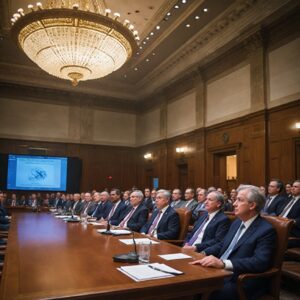Highlights:
– Chinese investments in the U.S. have significantly declined since Trump’s first term
– Tech companies like Damac and SoftBank are pouring billions into data centers and AI development in the U.S.
– Trump’s approach to Chinese investment in the U.S. remains uncertain
The Decline of Chinese Investments in the U.S.
Chinese investments in the U.S. have seen a sharp decrease since Trump’s first term, with just $860 million flowing into the country in the first half of 2024. This is a significant drop from the $46.86 billion in 2017 when Trump initially took office. Trump’s tough stance on China, marked by threats of additional tariffs, has deterred Chinese companies from investing in the U.S. as the political climate remains uncertain.
The decline in Chinese investments is also attributed to regulatory policies established by both Beijing and Washington to restrict certain sectors from Chinese involvement. This shift has led Chinese companies to explore alternative investment strategies, such as forming joint ventures with U.S. businesses or engaging in greenfield investments to build enterprises from scratch.
Deal-making Strategy?
President Trump has hinted at utilizing tariffs to influence Chinese investment in the U.S. by emphasizing the importance of building manufacturing plants in America to create jobs and wealth. Despite this rhetoric, Chinese companies have shown interest in U.S. ventures, with battery giant CATL expressing willingness to establish a U.S. plant if Trump permits. However, the unpredictability of Trump’s policies casts doubt on the sustainability of future Chinese investments in the U.S.
While Trump’s administration previously lifted restrictions on Chinese companies like ZTE, the landscape for Chinese investment in the U.S. remains uncertain. Advocacy groups and analysts emphasize that welcoming Chinese investment requires long-term commitments and a stable regulatory environment. The future scenario for Chinese investments in the U.S. is marked by caution due to the shifting political and economic dynamics between the two nations.
Impacts and Future Prospects
The current trends indicate a cautious approach from both Chinese investors and the U.S. regulatory bodies, with Chinese companies now focusing more on smaller ventures rather than large acquisitions. The uncertain future of U.S.-China relations under Trump’s administration raises questions about the feasibility of long-term Chinese investments in the U.S. Will future policies encourage or deter further Chinese investments, and how will these decisions shape the economic landscape between the two countries?
In this evolving landscape, how can both nations seek mutually beneficial strategies to foster economic growth and innovation through cross-border investments? As the global market dynamics continue to shift, what collaborative opportunities can be explored to ensure a balanced and sustainable investment environment between China and the U.S.?
The content is provided by Jordan Fields, Financial Pulse Now


























